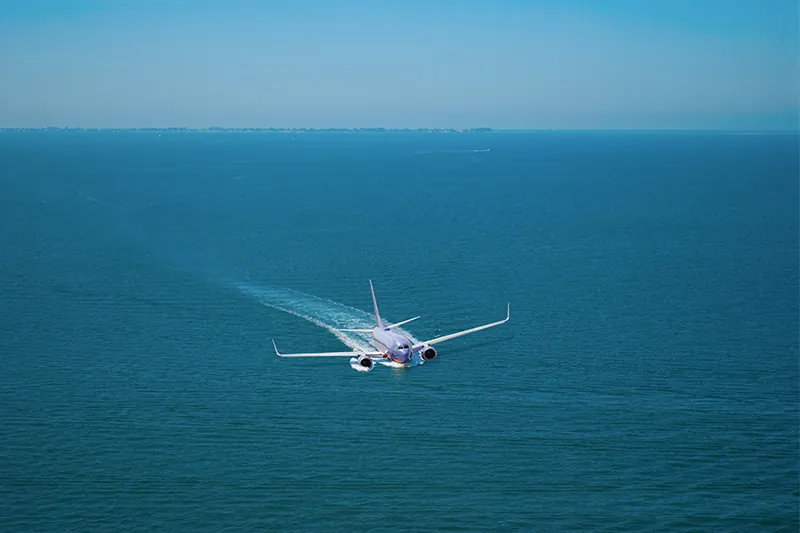When your life is on the line, leave it behind.
That’s the takeaway from too many tragic plane emergencies, including the May 2019 explosion of Aeroflot flight 1492 in Moscow, which killed 41 people. In that incident, a lightning strike forced the pilots to make an emergency landing. The plane caught fire but remained intact, and passengers were prompted to evacuate.
However, as details about the incident emerged, investigators signaled that more people could have survived if not for one preventable reason. Video shows passengers dragging carry-on bags with them as they flee the burning plane, and reports suggest the evacuation was slowed by people retrieving their belongings from the overhead bins.

“Reports from people on the plane indicate the evacuation may have been slowed by passengers grabbing their bags. Videos show passengers taking their carry-on bags with them as they exited the plane,” the Association of Flight Attendants said in a statement. “We will never know if more lives could have been saved if the bags were left behind.”
The purpose of posing this question is not to blame the victims of a tragic incident. However, it is a reminder that it’s always worth a refresher on what to do—and what not to do—when you need to evacuate in a plane emergency.
Your Bags Are Never Worth It
The tragic Aeroflot emergency is not the only aviation incident in recent years that has brought in-flight safety to the forefront of travelers’ minds. This year alone saw the collision and evacuation of Japan Airlines flight 516, an easyJet flight filled with smoke on the runway, and a string of safety issues with the Boeing 737 Max aircraft, prompting passengers to pay extra attention to the safety demonstration.
If you find yourself in an evacuation situation, the Federal Aviation Administration (FAA) makes no mistake about it: “If an emergency evacuation is necessary, leave your carry-on items on the plane. Retrieving personal items may impede the safe evacuation of passengers.”
This bears repeating because, as we’ve reported in the past, people seem inclined to do the opposite. During a recent incident in which a laptop caught fire in the cabin of an American Airlines flight, evacuation was stalled by passengers attempting to retrieve their hand luggage against the instruction of the flight attendants. Understandably, the idea of leaving things behind is difficult to accept—losing a laptop, passport, or cash can be an inconvenience. Or perhaps the banality of modern airline travel makes travelers complacent in emergency situations, thinking the danger or urgency is overblown. If that’s the case, though, you’ll likely see your possessions again soon.
It’s also worth nothing that with seat sizes shrinking and plane cabins getting more crowded than ever, it could take longer than you’d think to evacuate. The FAA, in guidelines set forth in 1967, states that commercial aircraft should be able to evacuate completely in 90 seconds. According to an NPR report, it took approximately 5 minutes to complete the evacuation of passengers aboard Japan Airlines flight 516 and 18 minutes for the captain to finally disembark, demonstrating that even a well-executed evacuation can take far longer than the FAA’s standard.
What to Always Do
But as safe as airline travel is, incidents like the Aeroflot fire illustrate the fine line between surviving and perishing in non-crash situations. So, even though you may know the standard onboard safety presentation by heart, here are a few must-do tips for evacuating a plane quickly:
- Look: Locate the nearest emergency exit when you take your seat so you know which way to go. Count the number rows between you and the nearest exit in case you need to navigate in the dark.
- Listen: In the event of an emergency, listen to the flight attendants’ instructions and follow them precisely. Remember, they’re trained for this.
- Leave it behind: Everything in your baggage can be replaced. Your life or well-being, and that of your fellow passengers, cannot.
You Might Also Like:
• US Issues Unusual Travel Warning for Popular Caribbean Country• 4 Common Travel Disasters and How to Prevent Them
• The Ultimate Toiletry Kit Packing List
• 6 Ways to Avoid Getting Sick After Flying
• 5 Hotel Nightmares That Could Happen to You
We hand-pick everything we recommend and select items through testing and reviews. Some products are sent to us free of charge with no incentive to offer a favorable review. We offer our unbiased opinions and do not accept compensation to review products. All items are in stock and prices are accurate at the time of publication. If you buy something through our links, we may earn a commission.
Related
Top Fares From Columbus, OH
Today's Top Travel Deals
Brought to you by ShermansTravel
Shop and Save with Country Inns...
Patricia Magaña
 Hotel & Lodging Deals
Hotel & Lodging Deals
$229 -- Chicago: Discounted Rates and...
Francesca Miele
 Hotel & Lodging Deals
$229+
Hotel & Lodging Deals
$229+
$188 -- Honolulu: Save on Oceanview...
Abigail Lamay
 Hotel & Lodging Deals
$188+
Hotel & Lodging Deals
$188+




